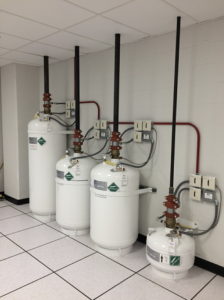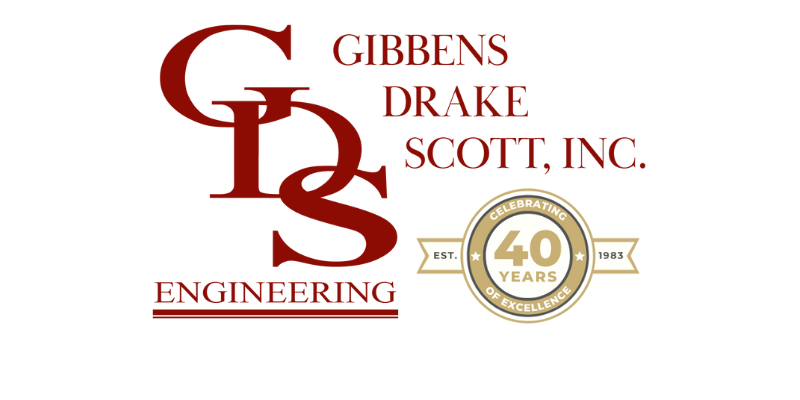Fire Suppression Systems
Steve Rios is back again, taking a look at the types and applications of fire suppression systems. As you can see from these posts, there are many building scenarios that lend themselves to the use of a particular fire protection system and/or a combination thereof. GDS has experience with these systems and is able assist with identifying those systems that would be required for your particular facility. Most importantly, we view this service as an added value to our clients by integrating these systems with our mechanical and electrical designs to promote life safety.
There are several types of fire suppression systems:
- Foam Extinguishing Systems
- Carbon Dioxide Extinguishing Systems
- Dry Chemical Extinguishing Systems
- Dry Powder Extinguishing Systems
- Wet Chemical Extinguishing Systems
- Water Spray Fixed Systems
- Water Mist Systems
- Clean Agent Fire Suppression Systems
A Foam Extinguishing System is a special application system that discharges a mixture of water and foam concentrate, resulting in a foam spray from the sprinkler. These systems are usually used with special-hazard associated with high-challenge fires, such as airport hangers and flammable liquids.
Carbon Dioxide Extinguishing System can be used on many types of fires, such as surface fires, flammable liquids, and most solid combustible materials. It should be noted that because of the displacement of oxygen, a carbon dioxide system will fail to support life; thus care should be exercised in its application. Typical applications for high-pressure carbon dioxide system include spray booths, commercial fryers, dip tanks, dust collectors and bag houses, electrical cabinets, printing presses, and storage vaults.
Dry Chemical Systems use either Class ABC or Class BC dry chemical to suppress fire. Pound for pound, dry chemical suppresses more fire than any other agent, providing both rapid suppression and protection against fire re-ignition. The sodium bicarbonate-based dry chemical is more effective than water on Class B (flammable liquid) and Class C (electrical) fires. ABC dry chemical also suppresses Class A (wood, paper, cloth) fires. Both are environmentally safe, non-toxic and economical to use in both initial installations and recharge situations. Dry chemicals are most effective and most often used on surface fires.
Wet Chemical Extinguishing System agents consist of organic or inorganic salts mixed with water to form an alkaline solution that is typically discharged though a piping and nozzle system when activated. Wet chemical agents are listed for the suppression of fires in commercial cooking equipment (Class K) such as deep-fat fryers, griddles, range tops and broilers. These agents are considered to be non-toxic and non-carcinogenic. Wet chemical systems typically are pre-engineered systems, defined by predetermined flow rates, nozzle pressures, and quantities of agent required. Wet chemicals are usually stored in cylinders adjacent to the hazard and are activated by either manual or automatic means.
Dry Powder Extinguishing System agents are different from dry chemical extinguishing agents and are effectively used to put out Class D Fires, which are metal fires. Certain metals, such as sodium, titanium, magnesium, potassium, uranium, lithium, plutonium, and calcium, are flammable. Magnesium and Titanium fires are common. The two familiar dry powder extinguishing agents for controlling combustible metal fires are graphite and sodium chloride. Dry powder systems should not be confused with dry chemical systems, which typically are associated with extinguishing agents suitable for use on flammable liquids. Primarily utilized for labs and manufacturing operations.
Water spray systems are operationally identical to a deluge system, but the piping and discharge nozzle spray patterns are designed to protect a uniquely configured hazard, usually being three-dimensional components or equipment. Fixed water spray systems are most commonly used to protect equipment from exposure fires such as flammable liquid and gas tanks, piping and equipment, and electrical equipment such as oil-filled transformers.
Water mist systems utilize water as the extinguishing, suppression, or control medium, but they do so in a nontraditional manner. The systems are designed to discharge less water using small-diameter piping, thus having less overall weight than a standard sprinkler system. When a fire condition is detected in the protected hazard area via a heat or smoke detector, the system control panel sends a signal to the releasing module to operate the water mist suppression system. When the system is operated, valves on nitrogen tanks open, and the resulting air pressure drives water through the opened water valve and to the system nozzles. The specifically designed nozzles create distinct water droplet characteristics for the applied hazard, and the resulting water mist contains a variety of droplet sizes. The larger droplet produced by the nozzle provide the necessary energy and momentum to carry the smaller droplets to the base of the fire, where the mist vaporizes and extinguishes the fire. Because this system produces a very small amount of actual water residue it is being used in mission critical facilities.
Clean Agent Systems are designed to be chemical inhibitors that react with the transient products of combustion, terminating the combustion chain reaction and thereby stopping flame propagation (refer to triangle below). They reduce the oxygen content below the point necessary to maintain combustion. They may be used in occupied areas if the design concentration does not exceed the “no observed adverse effect level” (NOAEL) of 43%. NFPA 2001 sets exposure limits for inert gases. Unnecessary exposure to inert gas agent systems resulting in low oxygen atmospheres shall be avoided. The maximum exposure in any case shall not exceed five minutes. People should evacuate from the protected area(s) during a countdown period between the verification of a fire and the release of any of these agents. This is a waterless fire suppression system that is specifically designed to protect sensitive computer, electronics and telecommunications equipment. Agents used include FM-200, HFC-125, NOVEC 1230.

Note: It is important to determine if the authority having jurisdiction (AHJ) and the owner’s insurance underwriter will allow a clean agent as either an alternative or an addition to a traditional sprinkler system. If a clean agent system is installed in addition to a sprinkler system to protect the same floor area, the sprinkler system should be designed to release water after the clean agent system has been exhausted.
Applicable Standards for above:
NFPA 11 Standard for Low-, Medium-, and High-Expansion Foam
NFPA 12 Standard on Carbon Dioxide Extinguishing Systems
NFPA 15 Standard for Water Spray Fixed Systems for Fire Protection
NFPA 16 Standard for the Installation of Foam-Water Sprinkler and Foam-Water Spray Systems
NFPA 17 Standard for Dry Chemical Extinguishing Systems
NFPA 17A Standard for Wet Chemical Extinguishing Systems
NFPA 750 Standard on Water Mist Fire Protection Systems
NFPA 2001 Standard on Clean Agent Fire Extinguishing Systems
